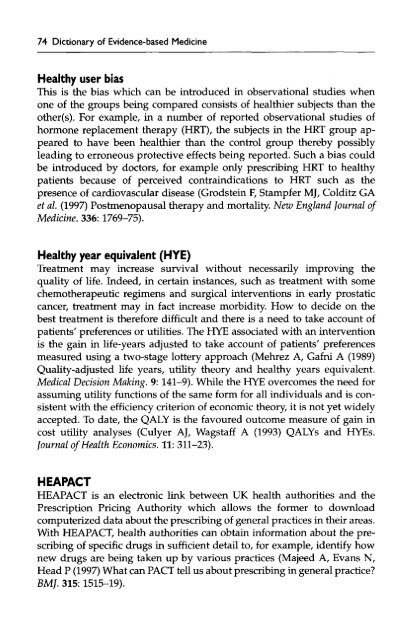Dictionary of Evidence-based Medicine.pdf
Dictionary of Evidence-based Medicine.pdf
Dictionary of Evidence-based Medicine.pdf
Create successful ePaper yourself
Turn your PDF publications into a flip-book with our unique Google optimized e-Paper software.
74 <strong>Dictionary</strong> <strong>of</strong> <strong>Evidence</strong>-<strong>based</strong> <strong>Medicine</strong><br />
Healthy user bias<br />
This is the bias which can be introduced in observational studies when<br />
one <strong>of</strong> the groups being compared consists <strong>of</strong> healthier subjects than the<br />
other(s). For example, in a number <strong>of</strong> reported observational studies <strong>of</strong><br />
hormone replacement therapy (HRT), the subjects in the HRT group appeared<br />
to have been healthier than the control group thereby possibly<br />
leading to erroneous protective effects being reported. Such a bias could<br />
be introduced by doctors, for example only prescribing HRT to healthy<br />
patients because <strong>of</strong> perceived contraindications to HRT such as the<br />
presence <strong>of</strong> cardiovascular disease (Grodstein F, Stampfer MJ, Colditz GA<br />
et al. (1997) Postmenopausal therapy and mortality. New England Journal <strong>of</strong><br />
<strong>Medicine</strong>. 336: 1769-75).<br />
Healthy year equivalent (HYE)<br />
Treatment may increase survival without necessarily improving the<br />
quality <strong>of</strong> life. Indeed, in certain instances, such as treatment with some<br />
chemotherapeutic regimens and surgical interventions in early prostatic<br />
cancer, treatment may in fact increase morbidity. How to decide on the<br />
best treatment is therefore difficult and there is a need to take account <strong>of</strong><br />
patients' preferences or utilities. The HYE associated with an intervention<br />
is the gain in life-years adjusted to take account <strong>of</strong> patients' preferences<br />
measured using a two-stage lottery approach (Mehrez A, Garni A (1989)<br />
Quality-adjusted life years, utility theory and healthy years equivalent.<br />
Medical Decision Making. 9: 141-9). While the HYE overcomes the need for<br />
assuming utility functions <strong>of</strong> the same form for all individuals and is consistent<br />
with the efficiency criterion <strong>of</strong> economic theory, it is not yet widely<br />
accepted. To date, the QALY is the favoured outcome measure <strong>of</strong> gain in<br />
cost utility analyses (Culyer AJ, Wagstaff A (1993) QALYs and HYEs.<br />
Journal <strong>of</strong> Health Economics. 11: 311-23).<br />
HEAPACT<br />
HEAPACT is an electronic link between UK health authorities and the<br />
Prescription Pricing Authority which allows the former to download<br />
computerized data about the prescribing <strong>of</strong> general practices in their areas.<br />
With HEAPACT, health authorities can obtain information about the prescribing<br />
<strong>of</strong> specific drugs in sufficient detail to, for example, identify how<br />
new drugs are being taken up by various practices (Majeed A, Evans N,<br />
Head P (1997) What can PACT tell us about prescribing in general practice<br />
BMJ. 315: 1515-19).










